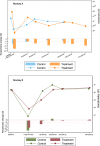Effects of corneal crosslinking on corneal shape stabilization after orthokeratology
- PMID: 32047218
- PMCID: PMC7012905
- DOI: 10.1038/s41598-020-59157-2
Effects of corneal crosslinking on corneal shape stabilization after orthokeratology
Abstract
Orthokeratology (Ortho-K) works to reshape cornea and is the only non-surgical way to enable vision without corrective aids. However, its effect is only temporary, and successful stabilization requires ongoing Ortho-K wear to maintain the reshaping effect. Corneal crosslinking (CXL) is a commonly-used technique in clinical practice to stabilize corneal shape in keratoconic eyes. However, whether or not CXL can stabilize corneal shape after Ortho-K in normal cornea has not been reported. Therefore, this proof-of-concept study using 2 rhesus monkeys aimed to determine the efficacy of the combined procedure. One monkey wore Ortho-K bilaterally for 24 hours, and the other from 6 pm to 8 am for 7 days. The left eyes of both monkeys underwent CXL after Ortho-K while the contralateral eye served as control. Results showed a gradual regression of corneal shape in all eyes with or without CXL. However, eyes underwent CXL regressed more slowly than the control eyes. The control eyes and the CXL treatment eye in the 7-day Ortho-K monkey regressed completely at last, while the CXL treatment eye in the 24 h Ortho-K monkey maintained a corneal flattening of -1.48 D 27 days after procedure. These findings suggest CXL can slow the regression of Ortho-K for a short duration, but cannot sustain its effect according to the current protocol.
Conflict of interest statement
The authors declare no competing interests.
Figures




References
MeSH terms
LinkOut - more resources
Full Text Sources

